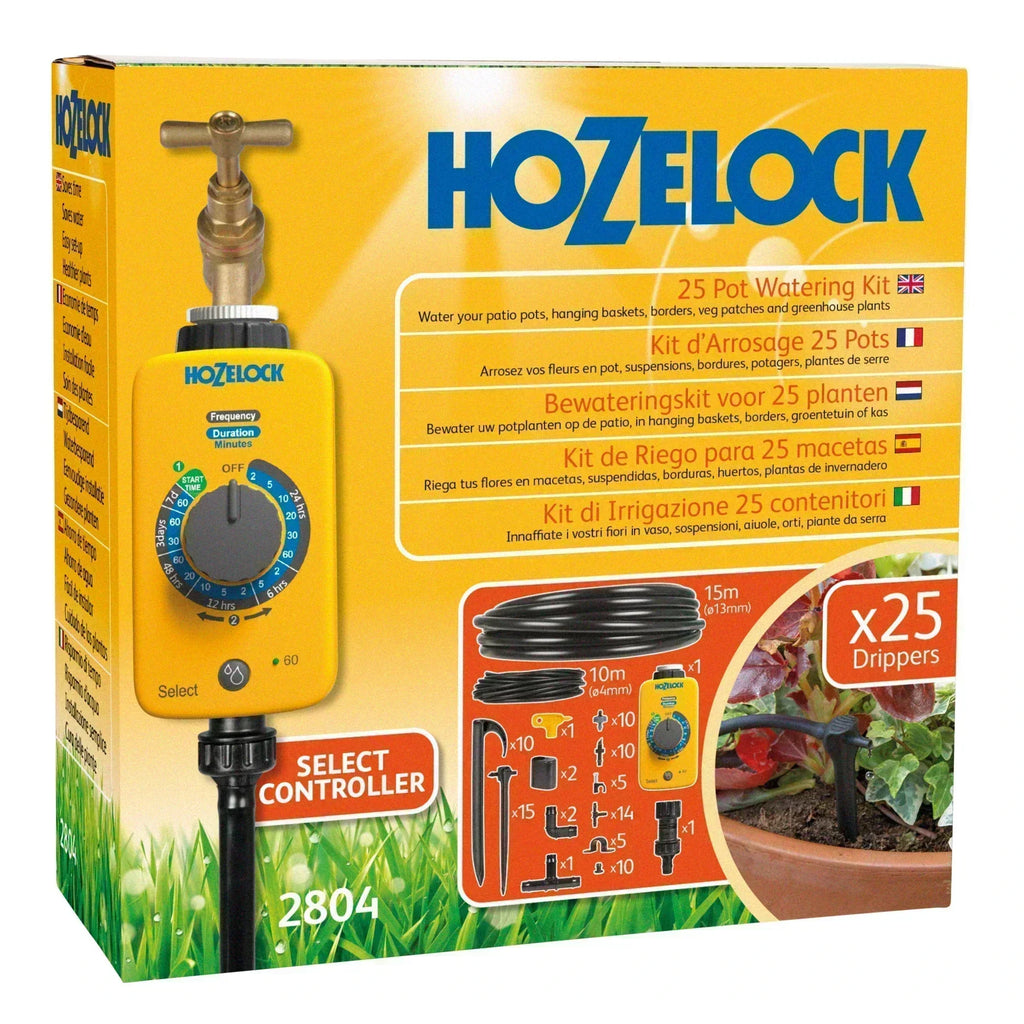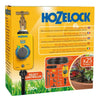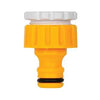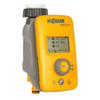We Compare the Hozelock Watering Kits 2802, 2803 and 2804

1. Overview
The three kits in question are:
-
Hozelock 15 Pot Watering Kit (SKU 2802)
-
Hozelock 20 Pot Automatic Watering Kit (SKU 2803)
-
Hozelock 25 Pot Watering Kit (SKU 2804)
They are all designed to be “automatic watering” or drip-irrigation systems for containers (pots, hanging baskets), borders, vegetable patches, greenhouse plants. They vary mainly in scale (how many plants / containers they support) and the controller/timer features.
2. Kit by Kit Breakdown
2.1 The 15 Pot Kit (2802)
-
This kit supports watering up to ~15 pots/containers.
-
Comes with a mechanical timer (manual dial) rather than a fully programmable electronic controller.
-
Includes 15 m of 4mm micro-tube, 15 drippers (4 LPH each) and the various connectors, stakes, wall clips.
-
Ideal for smaller patios, balconies, or a modest container garden where you want to “set and forget” the timer for a fixed duration.
-
Pros: Simpler, fewer features – good if you don’t need full automation; likely lower cost.
-
Things to check: Since it’s mechanical/manual timer, you’ll probably need to set it each time (unless you leave the dial set) — less flexible scheduling than the others.
2.2 The 20 Pot Kit (2803)
-
Supports up to ~20 pots.
-
Uses a “Select Controller” (electronic water timer) allowing more automation.
-
Comes with 15 m of 4mm micro supply tube and 20 drippers.
-
Ideal for a mid-sized patio or garden with more plants/containers, where you want the convenience of scheduled watering (for example while away).
-
Pros: More automation, supports more plants.
-
Things to check: Because you are managing more drippers/tubing, you’ll want to plan the layout carefully so each plant gets adequate water. Also ensure your tap and water pressure are suitable for the system.
2.3 The 25 Pot Kit (2804)
-
Supports up to ~25 pots/containers.
-
Comes with a more advanced controller — described as a “Select Controller” or “Sensor Controller” with daylight sensor, pre-set programmes etc.
-
Includes 15 m of 13mm supply tube + 10 m of 4mm micro tubing, 15 standard drippers + 10 end-of-line drippers, and a full range of connectors/adaptors to support the larger layout.
-
Ideal for larger patios, many containers, greenhouse plus borders, where you want high automation and may even incorporate a water butt.
-
Pros: Top-scale among these three; advanced controller features; better for larger setups.
-
Things to check: More expensive; more complex installation; you’ll need more space and good planning for the tubing layout and endpoint drippers.
3. What they all share
-
Drip emitters (4 LPH) that deliver water directly to the root zone of each plant: limits wastage, better plant health.
-
Flexible tubing system (can cut and join pipes/tubes) so you can customise layout to your garden/containers.
-
Pressure reducer/adapter included to ensure correct pressure for the drip system. (Seen in components lists)
-
Generally aimed at being “install-once, then forget” solutions for watering, saving time, effort and water. (Marketing emphasises “automatic watering”, “saves time & water” etc.)
4. Choosing the right one for you
Here are some questions & factors to help you choose:
-
How many containers/areas do you need to water? If you have ~10–15 pots, go for the 15 Pot kit. If ~20, the 20 Pot. If >20 or merging containers + borders + greenhouse, the 25 Pot might fit best.
-
Do you want full automation / programmability or is a simple mechanical timer enough? If you want set-and-forget, including holiday watering, go for a kit with the electronic controller (20 Pot or 25 Pot). If you just need a reliable setup with manual/dial timer, the 15 Pot suffices.
-
Space & layout complexity: A larger kit means longer tubing runs, more connectors and planning. If your container layout is compact and simple, the smaller kit may be easier to set up.
-
Budget: Larger kit = more cost. If you don’t need the advanced controller or the extra capacity, why pay for it?
-
Water supply & pressure: Ensure your garden tap and supply can support the tubing layout and drippers. Even though the kits include pressure reducers, layouts with long tubing runs or many drippers might see reduced flow if your supply is weak.
-
Future expansion: If you might add more containers later, you might buy a larger kit or ensure the kit you choose is expandable (many parts can be extended or extra drippers added). The documentation suggests that for larger requirements additional parts can be added.
5. Installation & Maintenance Tips
-
Before installation, map out where your pots/drippers will go: each dripper should be positioned at the root zone of a plant for best results.
-
Keep tubing runs as short and direct as practical; avoid sharp bends or kinks in micro-tube.
-
Use the wall clips/stakes provided to secure tubing and keep layout neat.
-
Use the pressure reducer or check manufacturer instructions to ensure you don’t exceed the pressure the drippers are rated for.
-
For the kits with electronic controllers: check battery life, timer settings, and test once after setting it up (e.g., manual “water now” function) to ensure correct operation.
-
Check the tubing and drippers periodically for blockages, wear or drips. Even the best systems can have leaks at connectors or blocked drippers if water quality is poor.
-
Winter care: In colder climates freeze-thaw can damage tubing or emitters. Drain if necessary or disconnect if you won’t use it in winter.
-
If you add a water butt or rainwater harvesting, ensure the kit is compatible (some kits mention compatibility). For example the 25 Pot kit mentions compatibility with water butts.
6. Final Thoughts
In short:
-
If you have a modest container setup and prefer something simple: go for the 15 Pot (2802).
-
If you have a moderate container area, want more automation and flexibility: the 20 Pot (2803) is a good mid-choice.
-
If you have lots of containers + borders + possibly greenhouse, and you want full automation: the 25 Pot (2804) gives you the capacity and features for the job.
All are solid options from a recognised brand in garden irrigation. Your selection really comes down to scale, automation requirements, and budget.







